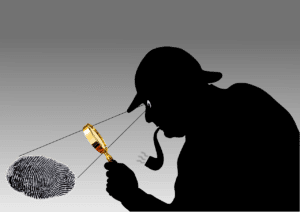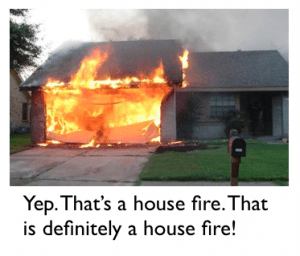 As we train our leaders to improve situational awareness it is important the lessons include a list of both positive and negative clues and cues. In the context of developing situational awareness, positive and negative does not mean good and bad. Rather, positive and negative means present and absent. Let me explain.
As we train our leaders to improve situational awareness it is important the lessons include a list of both positive and negative clues and cues. In the context of developing situational awareness, positive and negative does not mean good and bad. Rather, positive and negative means present and absent. Let me explain.
 Not all clues and cues are created equal
Not all clues and cues are created equal
In the process of developing situational awareness it all starts with perception. Or, if you’re a fan of Boyd’s OODA loop, observation. Name calling aside, it all begins with capturing the clues and cues in your environment and then processing them into meaning something. The problem is, some of the clues and cues… aren’t’ there. Really! They’re absent. You can’t see them or hear them. But nonetheless, they may be as important as any clue or cue you can see or hear. Thus, situational awareness is formed based on what you see and hear and what you don’t see and hear.
Positive clues and cues
 The positive clues and cues are the easiest to detect because they can be seen and heard. Understanding them, on the other hand is a completely separate matter and one that I have written and spoken about extensively. Notwithstanding the challenges with comprehension, it is relatively easy to train a responder on what to look and listen for at an emergency scene. At a fire scene, some of the positive clues and cues might be smoke, flame, construction (and decomposition), victims and wind. For a sick person, some positive clues and cues might be respiration and lung sounds, pulse, blood pressure, skin color and temperature, and pupil size and reactions. These are all clues and cues that can be seen or heard.
The positive clues and cues are the easiest to detect because they can be seen and heard. Understanding them, on the other hand is a completely separate matter and one that I have written and spoken about extensively. Notwithstanding the challenges with comprehension, it is relatively easy to train a responder on what to look and listen for at an emergency scene. At a fire scene, some of the positive clues and cues might be smoke, flame, construction (and decomposition), victims and wind. For a sick person, some positive clues and cues might be respiration and lung sounds, pulse, blood pressure, skin color and temperature, and pupil size and reactions. These are all clues and cues that can be seen or heard.
Negative clues and cues
Negative clues and cues are much harder to detect and may also be more difficult to comprehend their meaning, especially the first time they are encountered. Because negative clues and cues are not actually there – they cannot be seen or heard – they can slip by a responder rather easily.
One of the examples I like to share during a program is to ask a young person in the room if sick kids cry. They always respond in the affirmative. Then I ask them if really sick kids cry harder. Again, they respond in the affirmative. Then I find a seasoned medical responder in the audience and ask them if really sick kids cry. They always say “no.” Why? Because really sick kids – the ones on death’s doorstep – don’t cry. This is a negative clue that means a lot to a medical care team. If a responder did not know better, they might be lulled into thinking the kid who is quiet is not as sick as the kid who is crying.
Novices v. Experts
 When it comes to identifying positive clues and cues, novices and experts are about evenly matched. Again, notwithstanding there may be huge differences in the understanding of what the clues and cues mean, both are able to see and hear the same things. However, when it comes to negative clues and cues, the expert’s performance towers above the novice. To be able to “see” and “hear” clues and cues that are absent requires a deep understanding of what clues and
When it comes to identifying positive clues and cues, novices and experts are about evenly matched. Again, notwithstanding there may be huge differences in the understanding of what the clues and cues mean, both are able to see and hear the same things. However, when it comes to negative clues and cues, the expert’s performance towers above the novice. To be able to “see” and “hear” clues and cues that are absent requires a deep understanding of what clues and
Dr. Gasaway’s advice
 Novice officers should be assigned a mentor and spend time shadowing the expert during critical incidents that require decisions. The mentor can ask the novice to identify the clues and cues and draw a conclusion. The expert can then either affirm the conclusion or refute it with the addition of negative clues and cues the novice is unaware of. This can also be done in training scenarios and simulations using videos.
Novice officers should be assigned a mentor and spend time shadowing the expert during critical incidents that require decisions. The mentor can ask the novice to identify the clues and cues and draw a conclusion. The expert can then either affirm the conclusion or refute it with the addition of negative clues and cues the novice is unaware of. This can also be done in training scenarios and simulations using videos.
When experts draw different conclusions than novices, the simple act of the novice asking how the expert drew their conclusion might leave the expert without a good answer. This is because the expert may be doing the processing of negative clues and cues subconsciously. It may be hard for the expert to bring to words how they know what they know. This tacit knowledge (unconscious knowledge) is truly what separates experts from novices. An expert committed to sharing their knowledge will display patience and allow the novice to ask questions about how command decisions are made. Expert commanders, don’t think of this as defiance. Think of it as learning.
 Action Items
Action Items
1. Identify and discuss some specific positive and negative clues and cues for different types of emergencies you encounter (e.g., residential dwelling fire, motor vehicle accident scene, cardiac, etc.).
2. Discuss some strategies for teaching developing company officers and commanders how to identify both positive and negative clues and cues.
3. Following emergency calls, discuss the positive and negative clues and cues captured and evaluated that helped form situational awareness.
_____________________________________________________

If you are interested in taking your understanding of situational awareness and high-risk decision making to a higher level, check out the Situational Awareness Matters Online Academy.
CLICK HERE for details, enrollment options and pricing.
__________________________________
Share your comments on this article in the “Leave a Reply” box below. If you want to send me incident pictures, videos or have an idea you’d like me to research and write about, contact me. I really enjoy getting feedback and supportive messages from fellow first responders. It gives me the energy to work harder for you.
Thanks,

Email: Support@RichGasaway.com
Phone: 612-548-4424
SAMatters Online Academy
Facebook Fan Page: www.facebook.com/SAMatters
Twitter: @SAMatters
LinkedIn: Rich Gasaway
Instagram: sa_matters
YouTube: SAMattersTV
iTunes: SAMatters Radio
iHeart Radio: SAMatters Radio
